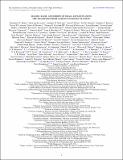MASSES, RADII, AND ORBITS OF SMALL KEPLER PLANETS: THE TRANSITION FROM GASEOUS TO ROCKY PLANETS
Author(s)
Seager, Sara; Winn, Joshua Nathan; Sanchis Ojeda, Roberto; Carter, Joshua Adam
DownloadMarcy-2014-MASSES, RADII, AND O.pdf (10.78Mb)
PUBLISHER_POLICY
Publisher Policy
Article is made available in accordance with the publisher's policy and may be subject to US copyright law. Please refer to the publisher's site for terms of use.
Terms of use
Metadata
Show full item recordAbstract
We report on the masses, sizes, and orbits of the planets orbiting 22 Kepler stars. There are 49 planet candidates around these stars, including 42 detected through transits and 7 revealed by precise Doppler measurements of the host stars. Based on an analysis of the Kepler brightness measurements, along with high-resolution imaging and spectroscopy, Doppler spectroscopy, and (for 11 stars) asteroseismology, we establish low false-positive probabilities (FPPs) for all of the transiting planets (41 of 42 have an FPP under 1%), and we constrain their sizes and masses. Most of the transiting planets are smaller than three times the size of Earth. For 16 planets, the Doppler signal was securely detected, providing a direct measurement of the planet's mass. For the other 26 planets we provide either marginal mass measurements or upper limits to their masses and densities; in many cases we can rule out a rocky composition. We identify six planets with densities above 5 g cm[superscript –3], suggesting a mostly rocky interior for them. Indeed, the only planets that are compatible with a purely rocky composition are smaller than ~2 R [subscript ⊕]. Larger planets evidently contain a larger fraction of low-density material (H, He, and H[subscript 2]O).
Date issued
2014-01Department
Massachusetts Institute of Technology. Department of Earth, Atmospheric, and Planetary Sciences; Massachusetts Institute of Technology. Department of Physics; MIT Kavli Institute for Astrophysics and Space ResearchJournal
The Astrophysical Journal. Supplement Series
Publisher
IOP Publishing
Citation
Marcy, Geoffrey W., Howard Isaacson, Andrew W. Howard, Jason F. Rowe, Jon M. Jenkins, Stephen T. Bryson, David W. Latham, et al. “MASSES, RADII, AND ORBITS OF SMALL KEPLER PLANETS: THE TRANSITION FROM GASEOUS TO ROCKY PLANETS.” The Astrophysical Journal Supplement Series 210, no. 2 (January 13, 2014): 20. © 2014 The American Astronomical Society
Version: Final published version
ISSN
0067-0049
1538-4365